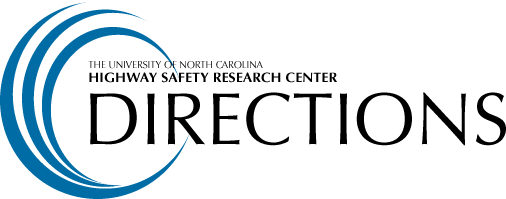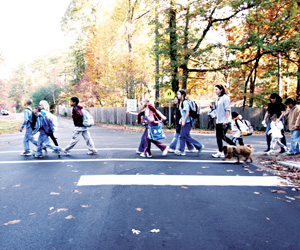

Advancing Transportation and Health: Six questions with Lauren Marchetti

The National Center for Safe Routes to School recently released the report Advancing Transportation and Health, which describes how communities are finding innovate ways to embrace the health and safety concepts at the core of the Safe Routes to School (SRTS) program. We spoke with Lauren Marchetti, HSRC senior program manager and director of the National Center for Safe Routes to School, about the report and its important takeaways.
Q: We hear a lot about the integration of transportation and health these days. What exactly does that mean?
A: Historically, the main health concern for transportation professionals and advocates has focused on injury prevention. Recently, much discussion has revolved around active transportation and its value for addressing the health concerns that are related to sedentary lifestyles. The Federal Safe Routes to School Program, established with the 2005 transportation legislation, was unique in that it identified as its goals both to make walking and bicycling to school safer but also to increase the number of students walking and bicycling.
In August 2012, I participated in the White House Roundtable on Health and Transportation, which discussed the intersection of health and transportation and the challenges of implementation. It became clear that the Federal SRTS Program has been able to use its unique purpose, which deliberately and consciously required both public health and transportation solutions, to successfully address many of the issues discussed. The National Center convened a SRTS Roundtable on Transportation and Health in March 2013 to build on this discussion.
Q: Advancing Transportation and Health describes how health and transportation topics are inter-related. How can a focus on health make SRTS and other similar programs resonate for a school or community?
A: Health and active transportation together are a natural fit, and many SRTS programs, through establishing partnerships between local departments of transportation and public health organizations, have received great support in working together toward achieving common goals. It is amazing how walking and bicycling to school can be one of the tools for creating many positive outcomes. Studies have demonstrated that SRTS strategies can positively impact academic achievement (e.g., Coe, et al., 2013); morning energy levels and attention (e.g., Kuo & Taylor, 2004); truancy/absenteeism (Mendoza, Levinger, & Johnston, 2009); and can improve schools and their communities through social bonding and community building (Miller & Scofield, 2009).
Q: The report shares several strategies for promoting transportation and health. Of the many SRTS programs that have implemented these strategies, does one stand out for having an impressive impact?
A: Each year we presented the Oberstar Safe Routes to School Award to a program that has demonstrated exceptional achievement. In 2012, that award went to SRTS Chagrin Falls in Ohio. Although 66 percent of students in Chagrin Falls live within two miles of school, fewer than 17 percent of students walked or biked to school in 2009. After the program, 26 percent of students regularly walk or bike to school, equivalent to an extra 70 students every day.
Program leaders surveyed parents and identified a lack of continuous sidewalks, dangerous street crossings and personal safety as key obstacles to children walking and bicycling to school. Using this information, the program:
- Improved the safety of the most commonly-used routes to school by building sidewalks, improving snow removal, enforcing school zone speed limits and implementing a “no right on red” policy at key intersections during school hours.
- Employed volunteer crossing guards to guide students through intersections near the school.
- Provided creative safety education programs and assemblies for students using the local community theater and student-to-student outreach campaigns.
Q: Data are specifically discussed in the report, including how SRTS programs use data prior to, during, and after, events like Walk to School Day. How are data used to inform decision making for programs?
A: Data collection allows us to see change over time, both at the local level and nationwide. When data collection is standardized – that is, when the same questions are asked at similar times over the course of several years – it can be used to help make decisions, create realistic goals, and determine what barriers are faced and how to adjust efforts to address those barriers in the future. In addition, quantifiable data that illustrate a program’s progress over time can help funding agencies justify continuing or expanding funding for a program, galvanize community support and start discussions about integrating health and transportation goals with other land use and travel demand management strategies.
Q: The National Center for Safe Routes to School coordinates registration for two large, national events every year. Holding events as a “tool for change” is also mentioned as a tactic in this report. What benefits have you seen from events?
A: One-day events are a way for a potential audience to try out a behavior change and event organizers report that the most common motivator for holding a Walk to School Day event is for physical activity promotion and obesity prevention. We’ve also learned from our post-event surveys that first-time events often lead to regularly-scheduled walk/roll to school programs. In fact, between 2006 and 2012, 50-75 percent of registered events led to policy or engineering changes such as: promotion of walking and bicycling to school policies; addition of crossing guards; additional signage; increased traffic enforcement near schools; and construction of sidewalks, paths and crosswalks.
These events grow in numbers every year that they have been held. Bike to School Day was started in 2012 as a companion to Walk to School Day. The growth it has seen in just three years is outstanding. The number of BTSD events increased 81 percent between 2012 and 2013, and 30 percent between 2013 and 2014. In its first three years it grew from 947 to 2,222 events, or 235 percent. I believe this success is because walking and bicycling connect with a desire for more active lifestyles that exists in communities across the country.
Q: How should other community groups use Advancing Transportation and Health to inform their own program choices?
A: Strategies from the SRTS program could be useful to other agencies, both government and private, that are working to address how we travel in ways that promote healthy lifestyles.
Training, branding, events, combining infrastructure and non-infrastructure, strong state-level leadership, and the rest of the Federal SRTS program’s accomplishments have helped the program gain support at local, state, and national levels. The local data collection system provides performance-based measures for planning and implementation, both of which are so much a part of how programs must operate in the future.
The full report is available on the National Center for Safe Routes to School website.
The University of North Carolina Highway Safety Research Center
730 Martin Luther King Jr. Blvd, Suite 300 | Campus Box 3430 | Chapel Hill, NC 27599-3430
Phone: 919.962.2203 | Fax: 919.962.8710
http://www.hsrc.unc.edu